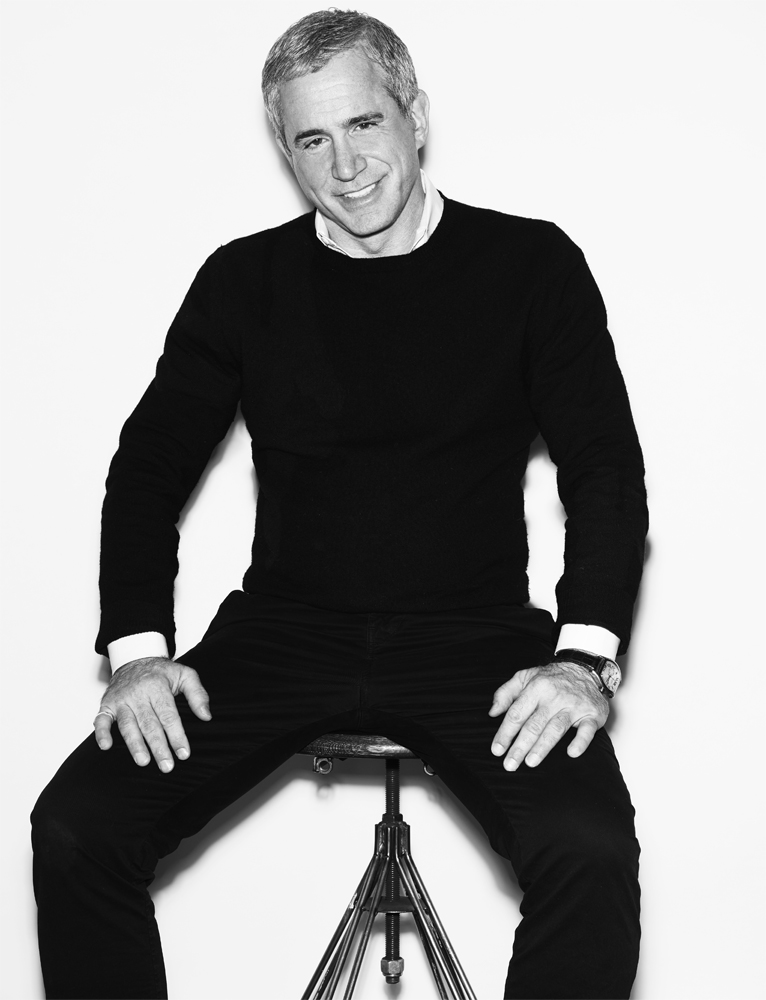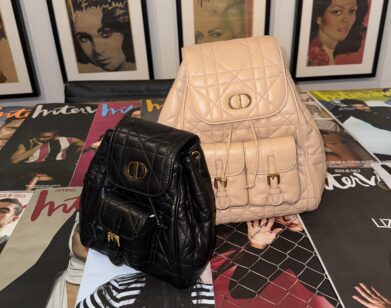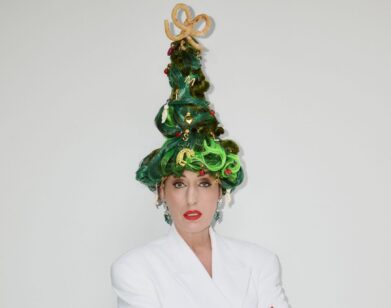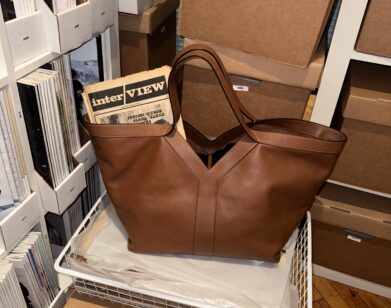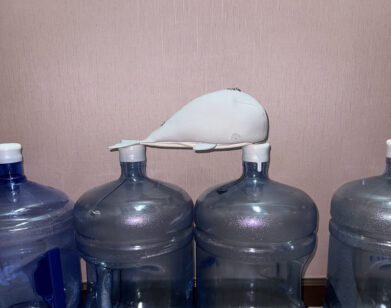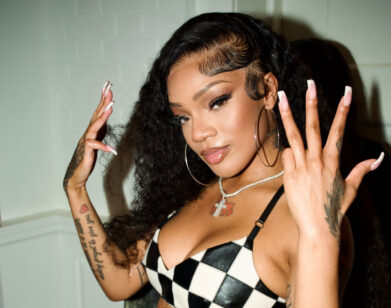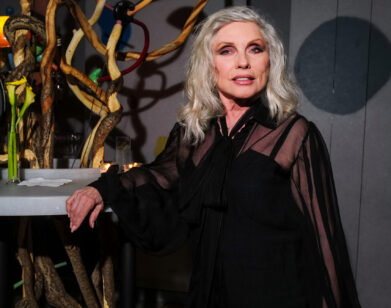Dennis Freedman
I too, want to activate the space. I want to create movement, change, unpredictability. DENNIS FREEDMANN
New York City does not have a great track record for preserving and celebrating its more radical cultural institutions. Gone without a trace are Warhol’s Factories, nightclubs like Max’s Kansas City and Studio 54, and most recently, all but the name of the Chelsea Hotel. But thankfully, Barneys, which has dictated New York style for more than 90 years, has managed the extraordinary feat of never falling out of style—and thus has assured its own perseverance. The ultimate fashion specialty store, which was founded in 1923 as a cut-rate suit shop (at that time, an innovation in itself), has almost single-handedly introduced European designers to America, reinvented the idea of collaborations with artists and boundary-breaking visual displays, and, what is often forgotten, been one of the early supporters of causes that range from AIDS research to the Fresh Air Fund. In a way, Barneys typifies New York—tough, glamorous, bohemian, and deep down running on a heart of gold.
This spring, Barneys has performed yet another miraculous feat—returning to its original Chelsea location on the corner of Seventh Avenue and West 17th Street. This is where the founder Barney Pressman opened his modest retail emporium, famously promising “No Bunk, No Junk, No Imitations.” While Barneys moved uptown to Madison Avenue in the early ’90s and eventually shuttered its Chelsea flagship, it never forgot its downtown roots. And now it’s landing back on the downtown grid to reclaim them—with a five-floor, 58,000-square-foot store designed by Steven Harris (complete with a rendition of its signature ’80s Andrée Putman spiral staircase). The man who for the past five years has been responsible for the overall visual image of Barneys (including its print, digital, and window design) is none other than former W magazine creative director Dennis Freedman. Freeman is the perfect ambassador for the store—erudite, endlessly curious, always pushing what’s possible, and an extraordinary devotee of art, interior design, and architecture. In his tenure at Barneys, the very idea of “windows” seems to have been invented only to be broken by him, and he’s found exceptional ways to baffle, surprise, and delight perhaps the most jaded population on the planet. His plans for the Chelsea store are no less provocative (among them, having artist Margaret Lee collaborate on windows for both Chelsea and Madison Avenue devoted to objects of desire during the Frieze Art Fair). Freedman spoke to his pal, the painter Lisa Yuskavage, about what it means to think in three dimensions and what has inspired him inside and outside of Barneys.
LISA YUSKAVAGE: Something I love about being an artist and living in New York City is the possibility of meeting wonderful, creative people who become lifelong friends who you would never meet anywhere else. I always love remembering the way we met and how enchanted that was. I would enjoy hearing your version of it.
DENNIS FREEDMAN: First of all, I can’t believe that was almost 13 years ago. At the time, I was the creative director of W magazine. One day I was having a conversation with Kate Moss, and she told me that Lucian Freud had just painted her portrait. I was fascinated by the fact that he chose Kate. I remember reading that Freud considered his work to be purely autobiographical, that his portraits are really about himself, and that he only paints people who interest him. From the very beginning, Kate Moss was the muse of W—her honesty, humor, and intelligence make her a compelling subject. I thought it would be interesting to see how other artists respond to her. This was in 2003, and the inclusion of fine artists in mainstream fashion magazines was not at all common. My interest was not to capitalize on the art world, but simply to introduce a different point of view. In addition to the artists, I also asked a number of fashion photographers who had worked with Kate and knew her well. The result was surprising. It was the artists, who only knew Kate through the lens of her public persona, who revealed the most unexpected and insightful aspects of her personality. When I was putting this project together, I spoke to Si Newhouse. He’s a very astute art collector and, in fact, owns one of the great Lucian Freud self-portraits. He asked me if I’d considered Lisa Yuskavage. I was a huge admirer of your work. So I called your gallery and asked if you would be interested. I heard back that you’d like to shoot her portrait, but only under the condition that you could reject it if you weren’t happy with the result. It was totally understandable. I’ll never forget the day I received your photograph. It was the most incisive of all the portraits. You photographed her on her knees, wearing candy-ball bikini bottoms, bare breasted, nipples erect, holding a dainty pink rosette patterned tea cup, with her Bardot blond wig blowing in the wind. You nailed it. The sexually provocative, prim-but-not-proper woman child. I never thought of it till now, but we never would have met if it had not been for Kate Moss and Si Newhouse.
YUSKAVAGE: My memory of it is close, but there are a couple things that you may not know. I was fairly unsure of taking on this assignment, as I was way out of my comfort zone on several levels: the first being that I do not do commissioned work; second, it was a photograph, and I’m awkward with cameras and all the technical parts of getting a photo to look like what I was looking for; and third, it was Kate Moss, and I just do not deal with any celebrities in my work nor have I since. There was a magical moment that I may not have ever shared with you about that day—I was looking through the camera lens and was so totally immersed in the work and was happy with what we were getting, and I just blurted out, “Wow, you are a really great model.” Kate very sweetly said, “Thank you,” and then I was in stitches thinking how silly of me, but what a real moment that was. She allowed me to forget who she was as far as her as a legend and just experience naively her genuine enchantment. But, yes, I did ask for permission to kill it if I felt that I failed, and then found out from you later that you never give that sort of option, so it was a great thing for me because I had great freedom to just try. As a creative director, you knew exactly how to work with me. Because of that first experience, I understood that you have a very rare insight and skill in coaxing and encouraging artists’ visions for these magazine projects and now collaborative window projects. I am quite certain that it begins with the fact that you genuinely love and respect artists. And that leads me to the next memory I have of your working life that impressed me greatly. It was around two years later, and we were already friends, and you called me all hopped up and asked me where I was. I was looking at shows in Chelsea, just wandering around by myself. You asked me to come see what you were doing across the street at the studio at Chelsea Piers. I walked over and you were directing a photo shoot with Richard Tuttle, who had designed and built and hand painted these extraordinary sets. Richard was a friend, and by then I also knew Mario Sorrenti through you, who was photographing it, so I stuck around because the energy was so positive and creative, and I found it more satisfying than any of the art I had just seen. There were some zaftig nude models lounging around, and Richard asked me very sweetly if I would like to jump in the set. I was tempted because you had the great dancer Jock Soto choreographing the models’ movements. There were so many layers of intelligence that went into that shoot. Can you unpack how you put that project together?
FREEDMAN: I remember clearly the moment you walked in the door to our studio at the Chelsea Piers. It was the first day of the first shoot of the first art issue of W. It was 2005. I wanted to extend the boundaries of the magazine beyond the insular world of fashion. I wanted to give our readers the opportunity to see original work, commissioned for W, by a curated group of contemporary artists. I didn’t want artists to gratuitously incorporate fashion into their imagery. Foremost in my mind was to maintain the integrity of the work. As we were developing the first issue, I went to see the documentary film Ballets Russes [2005]. This dance company, founded by Sergei Diaghilev, was one of the most influential ballet companies of the early 20th century, in large part because of the extraordinary collaborations between choreographers, composers, artists, and dancers—people like Matisse, Picasso, Balanchine, and Stravinsky, among others. The first thing I did after I left the movie theater was call Richard Tuttle, who was a friend and an artist whose work I admired. At the time, he was mounting a huge retrospective at the Whitney Museum. In fact, he was in the middle of the installation when he answered the phone. I asked him if he would go see the film. A few days later he called. He, too, was inspired. I asked him if he would design and build a set for a photo shoot in collaboration with the great New York City Ballet dancer Jock Soto, the photographer Mario Sorrenti, the hairstylist Julien D’ys, and the makeup artist Linda Cantello. Without a moment’s hesitation, he said yes. Within a few days, I got another call from Richard. He asked me to come to his apartment. When I got there, he showed me the model of a set that he created for our collaboration. It was extraordinary. I was thrilled that he was so committed to the project. I remember being so excited on that first day in the studio as I watched Richard, wielding an extra-long roller brush, begin to paint his set. I wanted to share it with you, so I called and asked if you would drop by to see what we were doing.
YUSKAVAGE: You’ve always talked with great enthusiasm about emerging young artists and art dealers showing in small galleries in Chinatown, the East Village, and Brooklyn. You’re so passionate about this and often tell me and others about an artist whose work you’ve just seen or a new gallery you’re excited about and none of us have ever heard of, but they always become a big deal. What inspired you to explore this particular area of art and artists? And more importantly, where do you get your intel?
FREEDMAN: In the past few years, I’ve become more and more interested in the work of younger, emerging artists. I’m fascinated by the fact that they’re a part of a generation that has developed its own forms of communication. They speak a different language, a language born out of the monumental changes in media. I’m very interested to know how they receive and process information. And most importantly, how they express themselves creatively. In fact, my position at Barneys has allowed me to work with a lot of the young talent that I am so interested in. There is a really nice synergy between working with emerging artists and the legacy of Barneys fostering new designer talent and bringing them to our New York store—designers such as Azzedine Alaïa, Christian Louboutin, and Dries Van Noten. By nature, I’m very curious and obsessive. I ask a lot of questions. I talk to curators. I talk to other collectors. We all share information. Most importantly, I talk to the artists themselves. It’s so enlightening to get to know them on a personal level. To be able to have a dialogue. To be able to discuss subjects other than art. And of course, I spend a lot of time talking with their dealers. I have great respect for people like Oliver Newton and Margaret Lee at 47 Canal, Jasmin Tsou at JTT, Allegra LaViola and Meredith Rosen at Sargent’s Daughters, Todd von Ammon at Team Gallery, and Kai Matsumiya at the gallery that bears his name. All of these dealers have taught me so much and have spent a great deal of their time helping me gain a deeper understanding of their artists work. There are too many talented artists to list, but a few that I am particularly interested in include Anicka Yi, Tabor Robak, Stewart Uoo, Zoe Pettijohn Schade, Josh Kline, Margaret Lee, Cy Gavin, and Michele Abeles. As a matter of fact, in May, we’ll be collaborating with Margaret Lee on all of the window installations for both Madison Avenue and Chelsea. We’ve been working on this project for six months, and I think it’s a nice example of how, for even one of our biggest projects, we decided to collaborate with a younger, emerging artistic talent.
YUSKAVAGE: You made a big transition from being creative director at W and doing just print editorials to now being the creative director of Barneys, where you’re not just responsible for the print and digital work and overall image, but also the window installations. You are doing such innovative things with the windows—I was wondering how did you make that leap into the three-dimensional?
FREEDMAN: As we said before, jumping into unfamiliar territory often yields the best work. One advantage was that I had no preconceived notions of what a window should be. To me, it was merely a space 15 feet long, 6 feet deep and 10 feet high. And it held unlimited opportunities. I’m very inspired by the work of the Italian artist Pier Paolo Calzolari. He often uses materials that change over time. And one of the things he talks about is “activation of space.” I, too, want to activate the space. I want to create movement, change, unpredictability. The first person I contacted when I came to Barneys was James Patten, a designer who works on the ways people interact with technology and graduate of the MIT Media Lab. I wanted to learn about things that were unfamiliar to me, to see things that I had never been exposed to before. I also knew I had to build a team of people who could work in unconventional ways. It took some time, but in the end, I am now working with the most talented and innovative group of people of my entire career. Each person brings a different skill set to the table. Our goal is to experiment, take risks, and not be afraid to fail. For example, this past holiday we decided that we wanted to transform two of our windows into “ice lockers.” In one of the windows, we wanted to build monumental 10-by-15-foot ice castles, and in the other, have a team of ice sculptors carving life-size penguins in our windows every day for six weeks. To do this meant finding a way to create thermally insulated rooms. It took us six months of research, but we finally found a solution. It was a big risk because five months into the project we still didn’t know if it would be possible. The element of performance, to create theater for the streets, has been a key focus for us when designing our windows—whether it be having that ice carver in the windows or having Daphne Guinness get ready for the Met Ball inside of our windows in 2011. The thing that continues to motivate our team is that we are very much aware of the extraordinary legacy that we inherited. From its very beginning, Barneys has always pursued the unconventional. We are following in the footsteps of one of the greatest window designers of all time, Simon Doonan. No one has been more generous, encouraging, and supportive.
YUSKAVAGE: I admire Simon too. Prior to knowing you, I didn’t know anything about fashion and certainly not the history of windows, but through the enthusiasm that you bring to it, I’ve begun to realize that so much passion and genius resides in your world. People in your profession are artists in the best sense of the word in that they change how we see. I was happy to hear you say that you encourage yourself and your team to try things and not be afraid to fail. I can’t imagine how scary that is in retail, because it is hard enough in a studio with no one expecting a specific outcome. One of your great leaps into the unknown was your Spring 2014 campaign. You had Bruce Weber shoot transgender men and women modeling the clothes, and they were gorgeous, as were the photographs. You and Bruce also made several short but very moving films that allowed the models and their friends and families to share their experiences. You were one of the first brands to address and confront the issue of transgender equality, and I must say, it was powerful. It definitely stayed with me. It was going somewhere no one had gone so honestly and respectfully. Was this a difficult decision, and why did you decide to do it?
FREEDMAN: It was not difficult at all. Just the opposite. Part of the decision was personal. As a gay man, I have benefited a great deal from the progress that has been made in this country over the past decade. The discussion always centered on the LGBT community. But it was so painfully clear to me, that somehow, the T part of LGBT had been left behind. And I felt that we, Barneys, could help bring this to light and show our support for the transgender community. When I presented my idea to Mark Lee and Daniella Vitale, our CEO and chief operating officer and senior executive VP, the answer was immediate. Not a moment of hesitation. They both gave it their enthusiastic support and believed it was the right thing to do. There were two fundamental decisions that I made: the first was to hire Bruce Weber, because there is no one I have ever worked with who listens to and cares so deeply about the people he photographs; the other was that we had to tell the stories of each one of these young men and women. We had to tell their stories as well as the stories of those people, if in fact they existed, who gave them the love and support that they so desperately needed to make their journeys. I will always be grateful to Patricia Bosworth, who stopped working on her own autobiography, to take on this assignment. The casting director, Jennifer Venditti, spent six weeks scouting all over the world to find a group of young people who brought a wide range of experiences to our project—both the good and the bad. Our goal was to tell the truth. We worked directly with the National Center for Transgender Equality to make sure that we, ourselves, were educated and aware of the complexity of the issues. I will never forget the words of Brad Lindley, the father of a young boy who transitioned from male to female at an early age. He spoke so lovingly about his daughter, Eve. “I have to admit I was initially excited to have a son. I was thrilled at the idea of football and tinkering with electric trains. But I noticed early on that he was interested in more female stuff. I didn’t want him to be unhappy. I loved him then and I love her now.” This brings up an important point about our print campaigns. Although we photograph fashion, there is always a more ambitious goal. We want our photographs to talk about issues that are close to our heart, and more importantly, what we believe is close to the heart of our customers. Our current campaign is focused on New York. It’s called “Our Town,” and it is photographed and filmed by Bruce Weber. My request to Bruce was very simple: I asked him to make a “love poem” to our city. I stressed that it be inclusive of all the different communities, in all the different boroughs, to show the extraordinary cultural and ethnic diversity that makes New York the most fascinating city in the world.
YUSKAVAGE: For my final question, I’m very curious to know what inspires you?
FREEDMAN: That’s a pretty tough thing to narrow down. It’s kind of like asking what’s your favorite artwork or your favorite piece of music. But I’ll give it a try:
Peter Zumthor’s two great chapels, Bruder Klaus Field Chapel in Germany and St. Benedict in Switzerland.
Robert Venturi’s book Complexity and Contradiction in Architecture.
Fischli and Weiss’s film The Way Things Go [1987]
Philip Glass’s opera The Civil WarS: A Tree Is Best Measured When It Is Down and Modest Mussorgsky’s Boris Godunov.
Pier Paolo Calzolari’s salt works from the 1980s.
Guarino Guarini’s Royal Church of San Lorenzo in Turin.
Arundhati Roy’s novel The God of Small Things.
Tabor Robak’s seven-channel video installation, Xenix [2013].
Paul Taylor’s dance works Cloven Kingdom and Esplanade, and George Balanchine’s Serenade.
Louis Kahn’s National Assembly Building of Bangladesh and the Salk Institute in La Jolla.
Emilio Ambasz’s 1972 exhibition of Italian Design, Italy: The New Domestic Landscape, at the Museum of Modern Art, New York.
LISA YUSKAVAGE IS A NEW YORK BASED ARTIST.

